INTRODUCTION
The publication of incorrect and misleading results in the scientific literature can have severe consequences on clinical practice and upcoming academic endeavors. When an article is retracted, it means that a previously published paper has been found to include untrustworthy data and flawed methodologies or to have engaged in unethical research practices such as plagiarism, fabrication, and biased-fake peer review. The retraction process is vital in preserving the scientific literature’s integrity and credibility by ensuring that faulty or deceptive data is rapidly corrected and eliminated from the scientific environment.
123
The retraction notes should contain sufficient and balanced information regarding who retracted the publication and why the outcomes and data were deemed unreliable/misleading. In addition, offensive statements should be avoided, and a balance should be established when addressing retractions. Retraction notes should be straightforward, free, and readily accessible, with a link to the original retracted publications.
4
Kazakhstan, a non-English-speaking multinational country, has a rising economy and enormous research and scientific progress potential. Central Asian authors have had limited access to academic English resources for decades.
5 The analysis of publications in predatory journals revealed that a large percentage of these articles were submitted by researchers from Asia and Africa, many of whom had limited expertise and were non-native English speakers.
6 Additionally, the educational systems in Asian countries exhibit a notable dearth of emphasis on research methodologies and an insufficient prioritization of the intricate process involved in generating and disseminating scientific papers.
7
An additional concern arises from the influence of social media and internet-based platforms, wherein retracted articles persistently garner attention, thereby perpetuating the dissemination of erroneous and misleading information.
8
The present article focuses on Kazakhstan as the primary subject of investigation, wherein the subsequent principal points are scrutinized:
• The number of retracted publications from Kazakhstan and their distribution over the years.
• Analysis of retractions according to the publication type.
• Examination of the subject category and index status of the retracted publication sources.
• Evaluation of the subject areas of retracted publications.
• Documentation and listing of retraction reasons.
• Evaluation of retracted publications in terms of citations and Altmetric scores.
Go to :

METHODS
Data were obtained using the Retraction Watch Database (
http://retractiondatabase.org/RetractionSearch.aspx?) for this descriptive study. The Retraction Watch Database was chosen as the source for this research due to its broad coverage and comprehensive accumulation of retractions-related data. The database was deemed extremely useful for conducting the research because it contains a vast array of retractions data, including retractions’ causes, publication details, and pertinent contextual information. Retracted publications from Kazakhstan were searched on PubMed (
https://pubmed.ncbi.nlm.nih.gov/?term=%22retracted+publication%22%5Bpt%5D+and+Kazakhstan&sort=date), and a total of six articles were listed (date: July 10, 2023). This data confirms the comprehensiveness and extensive data network of Retraction Watch. Kazakhstan was chosen for the country option, and the listing was generated without restrictions.
Data extraction
The following data were recorded from the list: publication title, DOI number, number of authors, publication date, retraction date, source (journal, conference, congress, or book), publication type (research article, abstract, review article, or chapter), subject category of publication, collaborating country, retraction reason. The duration between the publication date and the retraction date was calculated. The time between the submission and accepted dates was calculated and recorded as peer review time. The sources’ indexing status in Web of Science (WoS), Scopus, PubMed, MEDLINE, and Directory of Open Access Journals (DOAJ) was reviewed and recorded. The open access status of the sources was searched and noted.
Scimago Journal & Country Rank (SJR) data was accessed via the website (
https://www.scimagojr.com/). SJR presents a public-facing platform that is accessible and free of charge.
9 The data of journals and other sources were accessed through SJR, and ‘subject area and category’ information was processed.
Scopus was chosen as the database for citation data due to its extensive content, involving a wide range of medical and other scientific fields.
10 By utilizing Scopus, citation data were obtained for the analysis.
A toolbar was obtained to access the publications’ Altmetric Attention Scores (AAS). The AAS is a metric designed to evaluate a publication’s influence based on the attention it receives across various online platforms. The interface permitted automatic and free retrieval of AAS for the publications.
11 AASs of publications noted.
Categorization of retraction notes
The retraction notes were classified using the following criteria
1213:
• Data-related concerns: Concerns about the accuracy or validity of the data, as well as cases when authors neglected to provide the raw data.
• Authorship issues and conflicts: This category involves examples of ghost authorship, one or more authors lacking appropriate knowledge or engagement, and post-publication conflicts of interest amongst authors.
• Plagiarism: Plagiarism is defined as the unacknowledged or improper use of an author’s text, sections, photos, opinions, or research designs without providing appropriate acknowledgment or citation to the original author.
• Duplication: Publication of the same scientific research, in whole or in part, more than once.
• Fake-biased peer review: Instances of fake reviewers or biased review processes that compromise the integrity of the peer review system.
• Informed consent issues: Failure to obtain informed consent from participants, insufficient information was given to participants, or misleading participants about the nature and purpose of the research.
• Ethical approval issues: Researchers either did not obtain ethics committee approval or did not adhere to the conditions and requirements established by the ethics committee, even when initial approval was obtained.
• Fraud: It is the deliberate falsification or misrepresentation of scientific research results or research process.
• Irregular citation pattern: Citation patterns that depart from scientific norms and exceed ethical bounds, such as excessive self-citation or citation manipulation.
• Fabrication: It denotes the act of generating or fabricating data or outcomes that do not exist in reality.
• Error: Unintentional errors or oversights that occur during the research process.
• No clear information: The retraction is notified, but no information regarding the nature of the violation is provided.
If an article was retracted for multiple reasons, each was documented and recorded separately. In articles with multiple subject areas, each was noted individually. All subject categories provided by SJR were recorded while determining subject categories of journals and other sources.
The study did not include human or animal subjects. No ethical approval was necessary as the analysis was performed exclusively on publicly accessible data. The data was visualized utilizing Microsoft Excel and presented as number (n), percentage (%), and median (minimum–maximum). The latest data update was executed on July 10, 2023.
Ethics statement
Ethics committee approval was not required for this study because there were no human or animal subjects, and open data analysis was done.
Go to :

RESULTS
A total of 92 retracted publications were listed using the specified search procedure. One repetitive article (with a preprint version) was excluded, and 91 publications were analyzed. In analyzing the retracted publications by year, most articles were retracted in 2022 (n = 22) and 2018 (n = 19). There were no articles retracted before 2010.
Fig. 1 depicts the distribution of data by year.
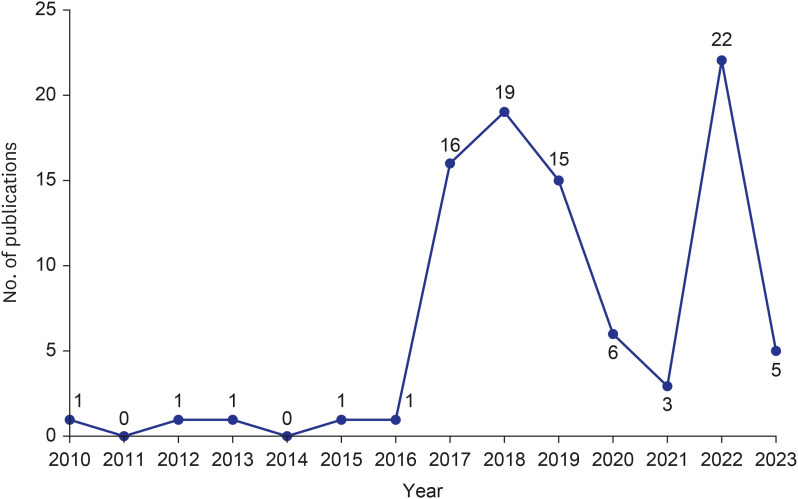 | Fig. 1 Distribution of retracted publications over the years.
|
The median duration between the publication date of the articles and the retraction date was 451 days, ranging from 27 to 2,074 days. The median duration for the peer review process was 58 days, ranging from 16 to 316 days. The median number of authors was 3 (1–13).
Of the publications, 49 (53.9%) were research articles, 39 (42.9%) were conference papers, 2 (2.2%) were review articles, and 1 (1.1%) was a book chapter (
Fig. 2).
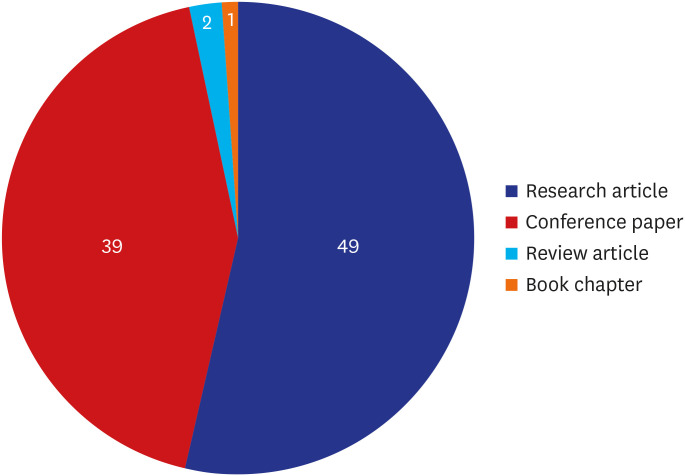 | Fig. 2 Distribution of retracted publication types.
|
There were 28 (30.8%) papers published in WoS-indexed sources, 34 (37.4%) in Scopus-indexed sources, 6 (6.6%) in PubMed-indexed sources, 5 (5.5%) in MEDLINE-indexed sources and 11 (12.1%) in DOAJ-indexed sources. Seventy-nine (86.8%) of the papers were published in open-access sources. The DOI numbers of 32 (35.2%) articles were not available in the Retraction Watch Database.
Russia (n = 24) and China (n = 5) were the most collaborative countries in the retracted publications (
Fig. 3).
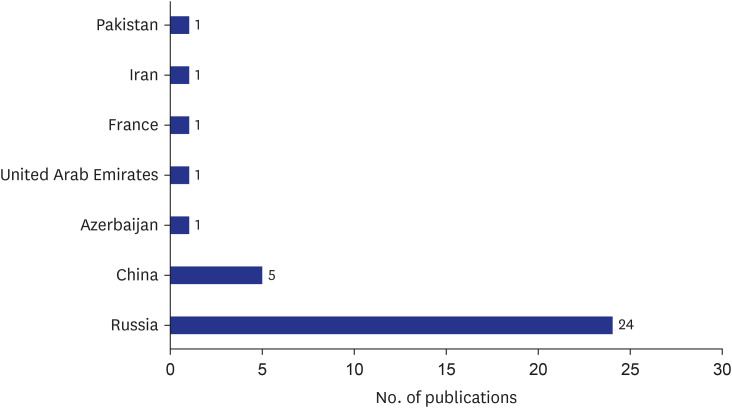 | Fig. 3 The collaborative countries of retracted publications.
|
The most common subject areas of retracted publications were education (n = 36), engineering (n = 24), technology (n = 17), psychology (n = 10), and mathematics (n = 6) (
Fig. 4).
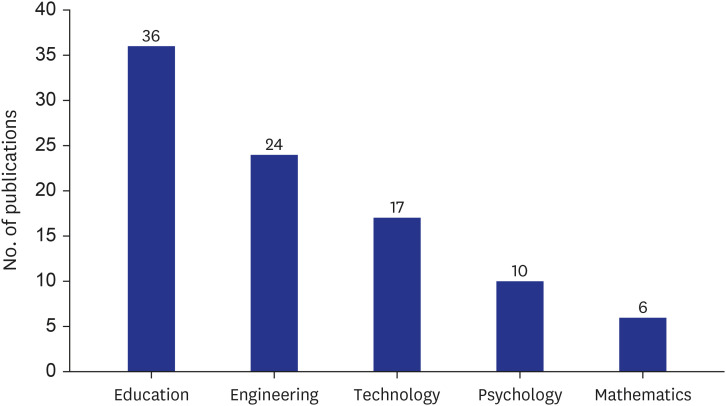 | Fig. 4 The main subject areas of retracted publications. Multiple subject areas are available.
|
When the subject categories of the sources were listed, engineering (n = 24), computer science (n = 21), education (n = 15), social sciences (n = 6), and medicine - healthcare (n = 6) occupied the top five places (
Fig. 5).
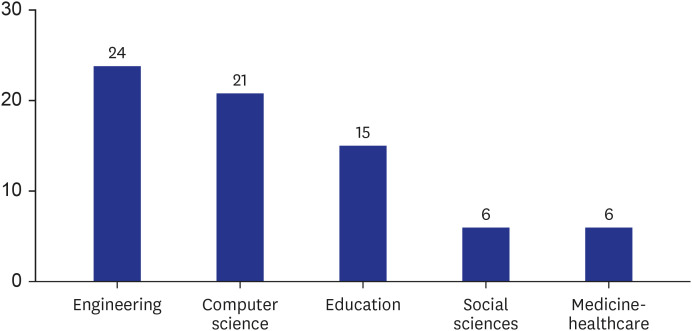 | Fig. 5 The main subject categories of the sources. Multiple categories are available.
|
The reasons for retracting the papers were examined and listed as follows: Fake-biased peer review (n = 38), plagiarism (n = 25), duplication (n = 14), authorship issues and conflicts (n = 13), fraud (n = 7), error (n = 5), ethical approval issues (n = 3), informed consent issues (n = 2), data-related concerns (n = 2), fabrication (n = 2), irregular citation pattern (n = 1), and no clear information (n = 1) (
Fig. 6).
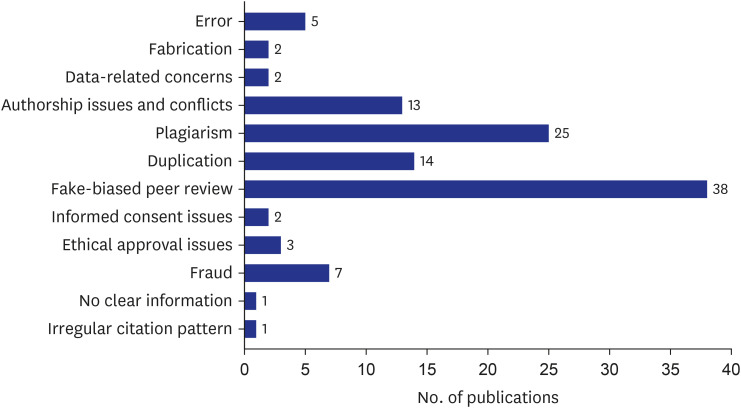 | Fig. 6 Number of publications by retraction reasons. Multiple reasons are available.
|
The top 5 sources, according to the number of retracted publications, were the
2018 International Conference on Computing and Network Communications (n = 19),
Thinking Skills and Creativity (n = 14),
Education in Russia and Abroad: Traditions and Challenges of a New Time (n = 13),
International Journal of Emerging Technologies in Learning (n = 4),
Modern Scientific Technologies (n = 2) (
Fig. 7).
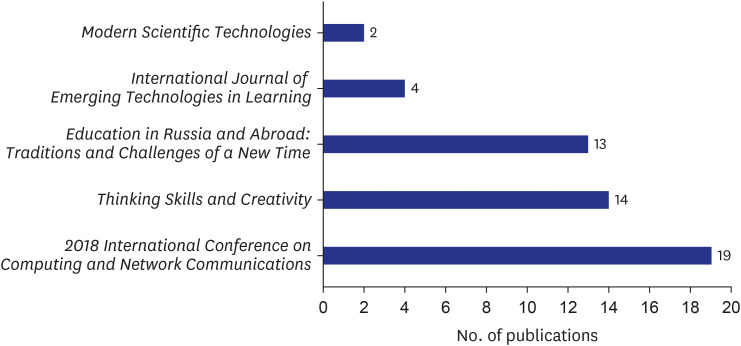 | Fig. 7 Top five sources in the number of retracted publications.
|
The median Scopus citation value of the publications was 1 (0–22). AAS of 11 publications were reached. The median value was 1 (1–10).
Go to :

DISCUSSION
The years with the most retracted articles were 2022 and 2018. Almost all of the retracted publications from Kazakhstan were research articles or conference papers. Russia and China were the primary collaborators in the retracted publications. The main subject areas of retracted publications were education, engineering, and technology. Engineering, computer science, and education were the most prominent subject categories among the sources. Fake-biased peer review, plagiarism, and duplication were the leading causes of retraction.
The first retracted article from Kazakhstan was in 2010, and there has been an increase since 2017 and has followed a fluctuating course. Several articles have demonstrated an upward trend in retraction numbers.
141516 The rise in the total number of papers published over time may have contributed to this result. One possible explanation is the editors’, authors’, reviewers’, and publishers’ growing awareness of retractions. The enhanced detection of retractions by software tools can also be a factor.
1718
The median duration between the publication and the retraction dates was 451 days. The median duration for the peer review process was 58 days. The lag time until retraction occurs varies across the studies.
121920 Efforts should be on shortening the lag time for retractions to minimize the spread of erroneous information and misleading data.
The vast majority of the retracted publications comprised research articles and conference papers. The extant body of literature posits that behaviors culminating in retractions exhibit a higher prevalence within the research articles.
1221 Nevertheless, it is a more accurate approach to accept that the dynamics of each country exhibit considerable variation. The current data suggest that the specified publication types should be evaluated more deeply in the peer review and post-publication processes. The enhancement of transparency in conference paper assessment processes is of particular importance.
A considerable portion of the papers appeared in sources not listed in major reputable indexes, including WoS, Scopus, PubMed, MEDLINE, and DOAJ. The median Scopus citation value of the retracted publications was 1. Additionally, DOI numbers could not be found in the database of just over a third of the publications. Kazakhstan is still in the middle of scientific development and has a long way to go. Inexperienced authors may seek academic success by focusing on low-quality sources. It may be challenging for Kazakh authors whose native language is not English to publish in reputable indexed journals that publish primarily in English.
22 At this time, it is critical that experienced editors and academics mentor Kazakh authors. By focusing on high-quality journals, Kazakh authors can limit the likelihood of retraction while also contributing to scientific advancement.
Russia and China were the most collaborative countries in the retracted publications, with Russia leading by a considerable margin. Throughout history, it is worth noting that Russia has had a considerable influence on the field of education and scientific endeavors in Kazakhstan. This influence has primarily been manifested through the adherence to directives and norms that were established within the Soviet Russian System.
5 Therefore, Russian dominance over retracted publications is an anticipated outcome.
The leading subject areas of retracted publications were education, engineering, and technology. Additionally, the main subject categories of the sources were engineering, computer science, and education. The huge volume of papers published in these disciplines may increase the number of retractions. In addition, academic competition may be fiercer in these subject areas, causing some researchers to employ unethical methods to differentiate themselves. The availability of substantial research funds and the potential for financial rewards may also play a role. There may be various reasons why the field of medicine - healthcare remains in the background in retracted publications. The number of articles produced in this field may be more limited. In addition, researchers in this field may be more experienced and less prone to unethical behaviors and undesirable errors.
The leading retraction reasons were fake-biased peer review, plagiarism, duplication, and authorship issues and conflicts. The reasons for retraction exhibit variability across different countries.
23 There may be differences between countries in the retraction trends.
24 The leading causes in India were plagiarism, fake data, and error.
25 Duplication, plagiarism, and fake peer review were the most common reasons for retraction in articles originating from Iran.
26 In the biomedical literature from China, plagiarism, error, and duplication came to the fore.
27 The aforementioned results suggest the presence of regional disparities in the retraction reasons. Various factors, including the scientific infrastructure of nations, the level of expertise possessed by researchers, and the extent of institutional support, have the potential to exert an influence on the outcomes. In Kazakhstan, where universities and academics are striving to advance in the field of science, it is crucial to prioritize education on retraction processes. Given that inexperience and lack of knowledge can contribute to certain retractions, the significance of education becomes evident. Collaborating with experienced researchers and editors, as well as seeking support from reputable institutions, would be beneficial in this regard.
AAS was only available for 11 articles, and the median value was 1. The AAS was developed mainly to assess the individual impact of an article using the attention gained across multiple Internet platforms.
2829 There may be several reasons for the limited AAS data associated with the retracted publication from Kazakhstan. It is difficult for articles in local languages, particularly in Russian, to attract global attention. The poor quality of the sources from which the articles are published may be another factor. Although low AAS scores are advantageous for retracted publications, strategies, in general, should be created to ensure that papers from Kazakhstan receive long-term attention on the Internet.
More than four-fifths of the articles were published in open-access sources. Traditional print-based subscriptions have given way to an open-access and digital model in scholarly publishing. However, this transformation has also spawned unethical and predatory publishing industry practices. Utilizing a “pay-to-publish” strategy, predatory journals exploit the open-access system to generate revenue for their editors-owners. Despite their false claims to the contrary, the most conspicuous characteristic of these journals is their lack of a rigorous peer review process.
3031
Retraction Watch provides access to the retraction reasons, but no comprehensive retraction notes are supplied. In comparison to PubMed, this is an intrinsic restriction of the database. Retraction Watch may not include reasons for the retraction of a small proportion of articles. It is critical to remember that the data only represents a snapshot in time, and that an article’s retraction can occur even after a long period of time, rendering the data dynamic. The present article provides descriptive data. Data was obtained only from Retraction Watch. Scopus and WoS were not used.
A notable result is a substantial rise in the number of retracted papers from Kazakhstan beginning in 2017. The vast majority of articles were published in sources not listed in reputable indexes. Fake-biased peer review, plagiarism, duplication, and authorship issues—conflicts came to the forefront as reasons for the retraction. The fields of engineering, education, and technology necessitate primary attention for retraction. The resolution of challenges associated with peer-review processes may be attainable through the implementation of enhanced mechanisms for managing professional journal-congress interactions. Implementing educational initiatives focused on plagiarism and duplication, devising comprehensive webinar sessions, and seeking assistance from globally experienced editors-researchers are viable strategies to effectively mitigate the retraction rates.
Go to :





 PDF
PDF Citation
Citation Print
Print



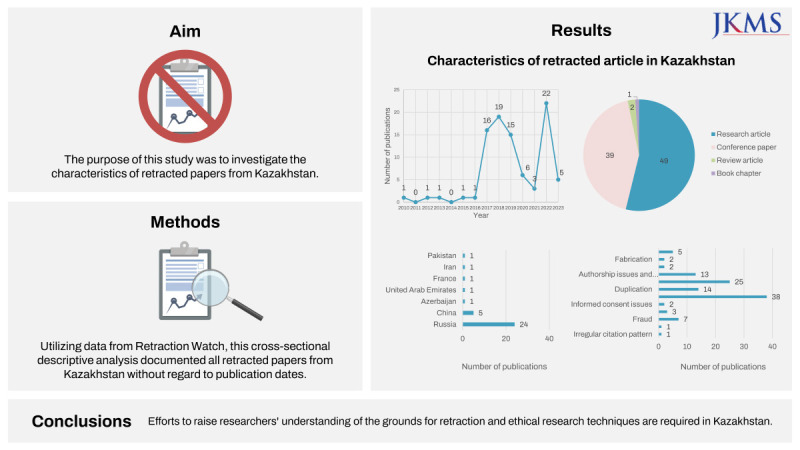







 XML Download
XML Download